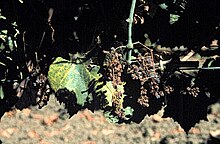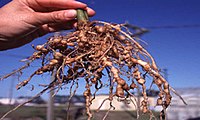Plant pathology
| Agriculture |
|---|
 |
|
|
This article includes a list of references, related reading, or external links, but its sources remain unclear because it lacks inline citations. (January 2011) |
Plant pathology (also phytopathology) is the scientific study of plant diseases caused by pathogens (infectious diseases) and environmental conditions (physiological factors). Organisms that cause infectious disease include fungi, oomycetes, bacteria, viruses, viroids, virus-like organisms, phytoplasmas, protozoa, nematodes and parasitic plants. Not included are ectoparasites like insects, mites, vertebrate, or other pests that affect plant health by consumption of plant tissues. Plant pathology also involves the study of pathogen identification, disease etiology, disease cycles, economic impact, plant disease epidemiology, plant disease resistance, how plant diseases affect humans and animals, pathosystem genetics, and management of plant diseases.
Plant pathogens
Fungi
The majority of phytopathogenic fungi belong to the Ascomycetes and the Basidiomycetes.
The fungi reproduce both sexually and asexually via the production of spores and other structures. Spores may be spread long distances by air or water, or they may be soil borne. Many soil inhabiting fungi are capable of living saprotrophically, carrying out the part of their lifecycle in the soil. These are known as facultative saprotrophs.
Fungal diseases may be controlled through the use of fungicides and other agriculture practices, however new races of fungi often evolve that are resistant to various fungicides.


Biotrophic fungal pathogens colonize living plant tissue and obtain nutrients from living host cells. Necrotrophic fungal pathogens infect and kill host tissue and extract nutrients from the dead host cells. See Powdery Mildew and Rice Blast images below.
Significant fungal plant pathogens include:
Ascomycetes
- Fusarium spp. (causal agents of Fusarium wilt disease)
- Thielaviopsis spp. (causal agents of: canker rot, black root rot, Thielaviopsis root rot)
- Verticillium spp.
- Magnaporthe grisea (causal agent of blast of rice and gray leaf spot in turfgrasses)
Basidiomycetes
- Rhizoctonia spp.
- Phakospora pachyrhizi (causal agent of soybean rust)
- Puccinia spp. (causal agents of severe rusts of virtually all cereal grains and cultivated grasses)
Oomycetes
The oomycetes are not true fungi but are fungus-like organisms. They include some of the most destructive plant pathogens including the genus Phytophthora, which includes the causal agents of potato late blight and sudden oak death.
Despite not being closely related to the fungi, the oomycetes have developed very similar infection strategies and so many plant pathologists group them with fungal pathogens.
Significant oomycete plant pathogens
- Pythium spp.
- Phytophthora spp.; including the causal agent of the Great Irish Famine (1845–1849)
Bacteria

Most bacteria that are associated with plants are actually saprotrophic, and do no harm to the plant itself. However, a small number, around 100 known species, are able to cause disease.[1] Bacterial diseases are much more prevalent in sub-tropical and tropical regions of the world.
Most plant pathogenic bacteria are rod-shaped (bacilli). In order to be able to colonize the plant they have specific pathogenicity factors. Five main types of bacterial pathogenicity factors are known:
1. Cell wall-degrading enzymes: These are used to break down the plant cell wall in order to release the nutrients inside. Used by pathogens such as Erwinia to cause soft rot.
2. Toxins: These can be non-host-specific, which damage all plants, or host-specific, which cause damage only on a host plant.
3. Effector proteins: These can be secreted into the extracellular environment or directly into the host cell, often via the Type three secretion system. Some effectors are known to suppress host defense processes.
4. Phytohormones: For example, Agrobacterium changes the level of auxins to cause tumours.
5. Exopolysaccharides: These are produced by bacteria and block xylem vessels, often leading to the death of the plant.
Bacteria control the production of pathogenicity factors via quorum sensing.
Significant bacterial plant pathogens
- Burkholderia[2]
- Proteobacteria
- Xanthomonas spp.
- Pseudomonas spp.
Phytoplasmas ('Mycoplasma-like organisms') and spiroplasmas

Phytoplasma and Spiroplasma are a genre of bacteria that lack cell walls, and are related to the mycoplasmas, which are human pathogens. Together they are referred to as the mollicutes. They also tend to have smaller genomes than true bacteria. They are normally transmitted by sap-sucking insects, being transferred into the plants phloem where it reproduces.
Viruses, viroids and virus-like organisms

There are many types of plant virus, and some are even asymptomatic. Under normal circumstances, plant viruses cause only a loss of crop yield. Therefore, it is not economically viable to try to control them, the exception being when they infect perennial species, such as fruit trees.
Most plant viruses have small, single-stranded RNA genomes. These genomes may encode only three or four proteins: a replicase, a coat protein, a movement protein, in order to allow cell to cell movement though plasmodesmata, and sometimes a protein that allows transmission by a vector.
Plant viruses must be transmitted from plant to plant by a vector. This is often by an insect (for example, aphids), but some fungi, nematodes, and protozoa have been shown to be viral vectors.
Nematodes

Nematodes are small, multicellular wormlike creatures. Many live freely in the soil, but there are some species that parasitize plant roots. They are a problem in tropical and subtropical regions of the world, where they may infect crops. Potato cyst nematodes (Globodera pallida and G. rostochiensis) are widely distributed in Europe and North and South America and cause $300 million worth of damage in Europe every year. Root knot nematodes have quite a large host range, whereas cyst nematodes tend to be able to infect only a few species. Nematodes are able to cause radical changes in root cells in order to facilitate their lifestyle.
Protozoa
There are a few examples of plant diseases caused by protozoa. They are transmitted as zoospores that are very durable, and may be able to survive in a resting state in the soil for many years. They have also been shown to transmit plant viruses.
When the motile zoospores come into contact with a root hair they produce a plasmodium and invade the roots.
Parasitic plants
Parasitic plants such as mistletoe and dodder are included in the study of phytopathology. Dodder, for example, is used as a conduit either for the transmission of viruses or virus-like agents from a host plant to a plant that is not typically a host or for an agent that is not graft-transmissible.
Physiological plant disorders
Significant abiotic disorders can be caused by:
- Natural
- Man-made (arguably not abiotic, but usually regarded as such)
Epidemiology
Disease resistance
Management
- Quarantine
- Wherein a diseased patch of vegetation or individual plants are isolated from other, healthy growth. Specimens may be destroyed or relocated into a greenhouse for treatment/study. Another option is to avoid introduction of harmful non-native organisms by controlling all human traffic and activity (e.g., AQIS) although legislation and enforcement are key in order to ensure lasting effectiveness.
- Cultural
- Farming in some societies is kept on a small scale, tended by peoples whose culture includes farming traditions going back to ancient times. (An example of such traditions would be lifelong training in techniques of plot terracing, weather anticipation and response, fertilization, grafting, seed care, and dedicated gardening.) Plants that are intently monitored often benefit from not only active external protection but also a greater overall vigor. While primitive in the sense of being the most labor-intensive solution by far, where practical or necessary it is more than adequate.
- Plant resistance
- Sophisticated agricultural developments now allow growers to choose from among systematically cross-bred species to ensure the greatest hardiness in their crops, as suited for a particular region's pathological profile. Breeding practices have been perfected over centuries, but with the advent of genetic manipulation even finer control of a crop's immunity traits is possible. The engineering of foodplants may be less rewarding, however, as higher output is frequently offset by popular suspicion and negative opinion about this "tampering" with nature.
- Chemical
- (See: pesticide application) Many natural and synthetic compounds that could be employed to combat the above threats exist. This method works by directly eliminating disease-causing organisms or curbing their spread; however, it has been shown to have too broad an effect, typically, to be good for the local ecosystem. From an economic standpoint, all but the simplest natural additives may disqualify a product from "organic" status, potentially reducing the value of the yield.
- Biological
- Crop rotation may be an effective means to prevent a parasitic population from becoming well-established, as an organism affecting leaves would be starved when the leafy crop is replaced by a tuberous type, etc. Other means to undermine parasites without attacking them directly may exist.
- Integrated
- The use of two or more of these methods in combination offers a higher chance of effectiveness.
See also
- Australasian Plant Pathology Society
- American Phytopathological Society
- Biological pest control
- British Society for Plant Pathology
- Burl
- Common names of plant diseases
- Forest pathology
- Fungicides
- Gene-for-gene relationship
- Global Plant Clinic
- Glossary of phytopathology
- Herbivory
- International Society for Plant Pathology
- List of phytopathology journals
- Mycology
- Pesticide
- Plant disease forecasting
- QoI
- Phytoplasma
- Plant virus
- Strobilurins
- Stunt
References
- ^ Jackson RW (editor). (2009). Plant Pathogenic Bacteria: Genomics and Molecular Biology. Caister Academic Press. ISBN 978-1-904455-37-0.
{{cite book}}:|author=has generic name (help) - ^ Bacteria as Plant Pathogens
External links
- International Society for Plant Pathology
- Australasian Plant Pathology Society
- American Phytopathological Society
- British Society for Plant Pathology
- Food Security Journal
- Contributions toward a bibliography of peach yellows, 1887–1888 Digital copy of scientist Erwin Frink Smith's manuscript on peach yellows disease.
- Erwin Frink Smith Papers Index to papers of Smith (1854–1927) who was considered the "father of bacterial plant pathology" and worked for the United States Department of Agriculture for over 40 years.
- Plant Health Progress, Online journal of applied plant pathology
- Pacific Northwest Fungi, online mycology journal with papers on fungal plant pathogens
- Rothamsted Plant Pathology and Microbiology Department
- Pathogen Host Interactions Database (PHI-base)
- Grape Virology
- Opportunity in Plant Pathology
